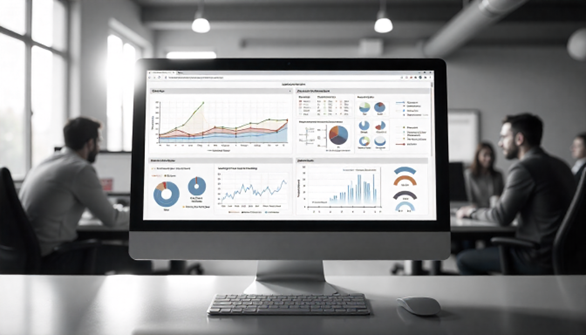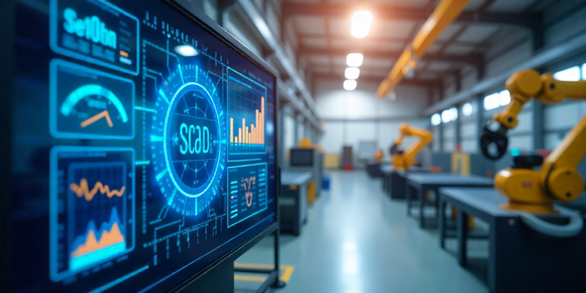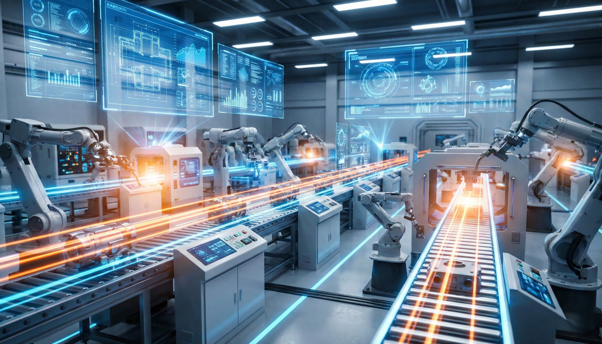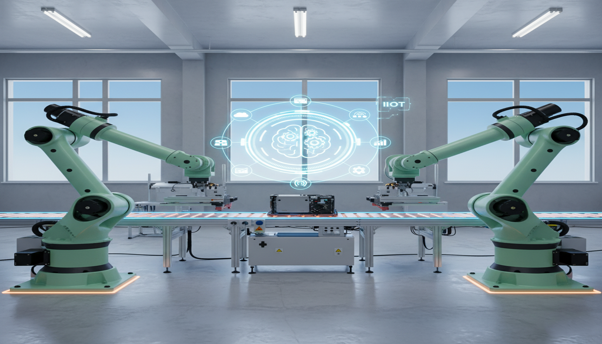Navigating the Industrial Landscape: Is SCADA the Same as IIoT?
In today’s fast-paced world of industrial automation and smart manufacturing, two terms often spark both curiosity and confusion: SCADA (Supervisory Control and Data Acquisition) and IIoT (Industrial Internet of Things). While they are sometimes used interchangeably, the reality is more nuanced.
At INGSOL, we recognize the importance of understanding these technologies clearly, as the future of efficiency, productivity, and innovation depends on them. In this blog, we’ll break down the differences, overlaps, and synergies between SCADA and IIoT, and explain why businesses should not view them as competitors, but as partners in transformation.
SCADA vs IIoT: What’s the Difference?

When it comes to industrial automation, SCADA and IIoT are often placed in the same basket. At first glance, they both deal with machines, data, and connectivity but in reality, they serve different purposes.
SCADA in Simple Terms
SCADA stands for Supervisory Control and Data Acquisition. Think of it as the eyes and ears of an industrial plant. It collects data from machines and sensors, processes it, and displays it on operator screens. SCADA also allows engineers to take action, like turning a valve on/off or adjusting production speed directly from their control room.
- It’s real-time focused: data is monitored continuously.
- It’s site-specific: usually tied to one factory, plant, or facility.
- It’s mission-critical: industries like energy, water treatment, and oil & gas rely on SCADA to avoid accidents and downtime.
Example: In a water treatment plant, SCADA shows tank levels, chlorine concentration, and pump status. If chlorine drops, SCADA alerts operators and lets them adjust dosing immediately.
IIoT in Simple Terms
The Industrial Internet of Things (IIoT) is broader and more connected. It’s like putting your SCADA data on steroids, expanding it beyond one facility and into the cloud, where powerful analytics tools process it.
- It’s cloud-driven: data goes beyond the local plant.
- It’s enterprise-wide: connects multiple plants, machines, and supply chains.
- It’s intelligence-focused: uses AI, machine learning, and predictive maintenance.
Example: That same water treatment company may run five plants across different cities. With IIoT, data from all plants is uploaded to the cloud, analyzed for trends, and shared with managers. If one plant shows unusual chemical usage, IIoT alerts the company before the issue spreads.
Imagine you are managing a fleet of cars.
SCADA is like having a dashboard in each car that tells you speed, fuel level, and engine health.
IIoT is like connecting all dashboards to your phone via the cloud, so you can see data for the entire fleet in one place and even predict which car will break down next.
SCADA in OT: Which Category Does It Fall Under?

SCADA falls under the umbrella of Operational Technology (OT).
Operational Technology refers to the hardware and software systems that directly monitor and control industrial equipment, machinery, and physical processes. It’s what makes factories, power plants, and utilities run smoothly every single day.
Some key examples of OT include:
SCADA systems – for supervisory control and data acquisition
PLC (Programmable Logic Controllers) – the “brains” that automate machines on the ground level
DCS (Distributed Control Systems) – control systems for complex processes like chemical or oil refineries
HMI (Human-Machine Interfaces) – the screens operators use to interact with machines
So, SCADA isn’t just a standalone tool. It’s one of the pillars of OT, serving as the supervisory layer that connects people with processes.
Why SCADA is Critical in OT
Within OT, SCADA has a special role; it acts as the command center.
Data Collection: It pulls information from machines, sensors, and remote terminals. Visualization: It presents the information in an easy-to-understand graphical interface.
Control: It allows operators to remotely adjust processes (like turning off a motor or opening a valve).
Without SCADA, operators would be blind to what’s happening across large, complex facilities.
Imagine a power grid operator without SCADA. They would have to manually check each transformer or substation. With SCADA, they can see real-time voltage levels and power flow across an entire state right from their control room.
OT vs IT: Where SCADA Differs
To fully appreciate SCADA’s category, it helps to understand the difference between OT and IT (Information Technology).
IT (Information Technology): Deals with data processing, storage, and communication for business operations (emails, ERP systems, cloud platforms).
OT (Operational Technology): Deals with physical operations, machines, equipment, and real-world processes.
SCADA belongs firmly in the OT camp, but in modern industry, it’s increasingly connected to IT through IIoT platforms. This convergence is known as IT-OT integration.
Real-World Example
Take a manufacturing company producing automotive parts:
The OT side (including SCADA, PLCs, and sensors) runs the production line, machines stamping, welding, and assembling parts.
The IT side manages business functions like inventory, supply chain, and order processing.
SCADA bridges the gap by feeding production data into IT systems, enabling smarter decisions (like adjusting output based on demand).
Is SCADA an Industrial Control System?

The short and straightforward answer is: Yes, SCADA is a type of Industrial Control System (ICS). But to truly understand what this means, let’s break it down step by step.
What is an Industrial Control System (ICS)?
An Industrial Control System (ICS) is an umbrella term for different types of control systems used in industrial environments to automate processes, monitor operations, and ensure efficiency and safety.
ICS includes several key systems:
SCADA (Supervisory Control and Data Acquisition), DCS (Distributed Control Systems), PLC (Programmable Logic Controllers)
Each of these has a unique role in controlling industrial operations. Together, they form the backbone of modern factories, power plants, oil refineries, and utility services.
Where SCADA Fits in ICS
Within the ICS family, SCADA takes the role of the “supervisor.”
SCADA’s job is not to directly control every machine (that’s the job of PLCs or controllers).
Instead, SCADA monitors all the data coming from machines, sensors, and remote systems, and gives operators the power to control processes remotely when needed. You can think of SCADA as the control tower at an airport. The pilots (machines/PLCs) actually fly the planes (do the work). The control tower (SCADA) oversees all flights, coordinates movement, and ensures everything operates safely.
Why SCADA is Essential in ICS
SCADA is considered one of the most critical ICS components because it enables:
Centralized Monitoring – One control room can oversee thousands of devices spread across different sites.
Remote Operations – Operators can open valves, stop pumps, or shut down equipment without being physically present.
Real-Time Decision Making – SCADA systems provide instant alerts for faults, leaks, or failures.
Operational Safety – By constantly tracking processes, SCADA prevents small issues from becoming large-scale disasters.
Real-World Example
Let’s take a water treatment facility:
PLCs handle tasks like opening/closing valves, pumping water, or regulating chemical dosing. SCADA supervises the entire water network, displaying real-time flow rates, water levels, and chemical balance on a central dashboard. If an operator sees that a pump has failed, SCADA can trigger an alarm and allow remote intervention, keeping the city’s water supply uninterrupted.
This is why SCADA is more than just software; it’s a mission-critical control system. SCADA vs Other ICS
It’s worth noting that while SCADA is a type of ICS, it differs from others:
DCS (Distributed Control Systems): Focused on controlling processes within one plant or facility.
PLCs (Programmable Logic Controllers): Control individual machines or processes at the ground level.
SCADA: Provides supervisory control and monitoring across large, geographically distributed operations like pipelines, grids, or city infrastructure.
SCADA in the IIoT Era
When we hear the term “SCADA in IoT,” it may sound like two different worlds coming together: one old and reliable, the other new and revolutionary. But in reality, the Industrial Internet of Things (IIoT) is not replacing SCADA , it’s making SCADA smarter, more connected, and more powerful.
Traditional SCADA vs. IIoT-Enabled SCADA
Traditional SCADA was designed as a closed system; it monitored machines, processes, and equipment within a specific plant or network. Data usually stayed local, and access was limited to control rooms.
SCADA in IoT (or IIoT-enabled SCADA) transforms this model by connecting SCADA to the cloud and IoT devices. This makes data available anytime, anywhere, and unlocks insights through advanced analytics, AI, and machine learning.
Imagine the difference between an old landline telephone (traditional SCADA) and a smartphone (SCADA in IoT). Both let you communicate, but the smartphone connects you to the entire digital ecosystem, offering apps, data, and global access.
How SCADA and IoT Work Together
A SCADA system in IoT integrates with connected devices, sensors, and platforms to create a next-generation industrial ecosystem. Here’s how:
Cloud-Based SCADA
SCADA applications are hosted in the cloud. Operators can monitor and control processes remotely via web browsers or mobile apps.
This ensures flexibility, scalability, and accessibility, perfect for organizations spread across multiple locations.
Smart Sensor Integration
IoT devices provide real-time granular data (temperature, vibration, pressure, energy usage, etc.).
These sensors feed directly into SCADA dashboards, giving operators a more detailed, accurate view of their systems.
Data Analytics & AI
IoT-enhanced SCADA doesn’t just show numbers on a screen. It can analyze trends, predict failures, and recommend actions.
Example: Instead of alerting when a pump fails, it predicts when the pump will fail, allowing predictive maintenance.
Cybersecurity & Remote Monitoring
With connectivity comes risk, so IIoT-enabled SCADA systems are designed with stronger cybersecurity protocols.
They allow secure remote access for field engineers, managers, and even automated AI agents.
Real-World Example of SCADA in IoT
Consider an oil pipeline network that stretches across multiple states: Traditional SCADA can track flow rates, pressure, and detect leaks. With IoT integration, the system can:
Predict leaks or ruptures using AI models. Send alerts instantly to operators’ mobile devices. Trigger automatic shutdowns in case of critical risks. Share performance data with cloud platforms for global monitoring.
This combination ensures safety, efficiency, and cost savings at a scale traditional SCADA alone could never achieve.
Benefits of SCADA in IoT:
Global Access – Monitor systems from anywhere in the world.
Deeper Insights – Leverage big data and AI to optimize performance. Faster Decisions – Real-time alerts for instant action.
Predictive Maintenance – Reduce downtime and maintenance costs.
Enhanced Security – Built-in cybersecurity layers for safe connectivity.
Will IIoT Replace SCADA?

This is one of the most common questions in the industrial automation world. With all the buzz around IIoT (Industrial Internet of Things), many professionals wonder if traditional SCADA (Supervisory Control and Data Acquisition) systems are becoming obsolete.
The short and simple answer is: No, IoT will not replace SCADA. Instead, it will enhance it. Why SCADA Still Matters
SCADA systems have been around for decades and remain the backbone of industrial operations. Here’s why they continue to be irreplaceable:
Mission-Critical Control
SCADA is built for real-time control and monitoring of industrial processes. In industries like power, oil & gas, water treatment, and manufacturing, seconds can make the difference between smooth operations and a shutdown.
SCADA ensures operators can react instantly to critical changes. Reliability and Security SCADA systems are designed to run 24/7 without fail.
They use dedicated communication protocols that are highly secure and less prone to internet-related disruptions. This makes them indispensable for industries where safety and reliability come first. Proven Infrastructure Many organizations have millions invested in SCADA infrastructure. Replacing them entirely would be costly, risky, and impractical.
What IoT Brings to the Table
While SCADA handles real-time operations, IoT introduces:
Advanced Data Analytics – IoT platforms can process massive amounts of historical and live data.
Cloud Integration – Access systems anytime, anywhere.
Connectivity – Link SCADA systems across multiple sites for a unified view.
Predictive Capabilities – IoT uses AI/ML to predict failures before they occur.
In short, IoT transforms SCADA from a reactive system into a proactive, intelligent ecosystem.
SCADA and IoT: A Symbiotic Relationship
Instead of viewing IoT as a replacement, it’s more accurate to see it as an evolutionary partner of SCADA.
Think of SCADA as the nervous system of an industrial operation, sensing, monitoring, and reacting in real time. Now imagine IoT as the brain analyzing data, learning patterns, and making smarter decisions.
Together, they create a next-generation industrial environment where SCADA ensures safe and stable operations.
IoT enables smarter planning, efficiency, and innovation.
Real-Life Example
Take the example of a smart manufacturing plant:
SCADA handles immediate tasks: controlling conveyor belts, monitoring machine health, and regulating temperatures. IoT platforms gather this data, analyze energy usage, predict maintenance needs, and suggest process improvements.
Without SCADA, real-time safety and control would be compromised. Without IoT, valuable insights and optimization opportunities would be lost. Together, they create a powerful synergy.
Future Outlook: Integration, Not Replacement
The future of industrial automation is not about choosing SCADA or IoT.
It’s about blending them: SCADA remains the operational core.
IoT extends its reach into analytics, connectivity, and digital transformation. Together, they enable Industry 4.0 and pave the way for smart factories, smart cities, and intelligent infrastructure.
The Four Types of SCADA Systems

Like all technologies, SCADA (Supervisory Control and Data Acquisition) has evolved. From its early days as a closed, standalone system to today’s web-based and IoT-powered platforms, SCADA has continuously adapted to meet the growing demands of industrial automation.
Broadly, SCADA systems are classified into four generations (or types), each representing a major leap in technology and capability. Let’s break them down.
First Generation – Monolithic SCADA Systems
The earliest form of SCADA, often referred to as “standalone systems”, emerged in the 1960s–70s. Key Characteristics:
No networking – Each SCADA system operated in complete isolation.
Mainframe Computers – Large, expensive, and powerful machines handled all control and monitoring tasks.
Basic Functionality – Operators could visualize data and control equipment, but only within a single facility.
Very Secure but Limited – Since there was no external connectivity, cyber risks were minimal, but so was scalability.
Example: Early power plant control rooms that used mainframe computers to track turbines, boilers, and valves. Think of this as the “analog TV” of SCADA – functional, but limited and localized.
Second Generation – Distributed SCADA Systems
As Local Area Networks (LANs) became common in the 1980s, SCADA systems entered the distributed era.
Key Characteristics:
LAN Connectivity – Multiple SCADA stations (RTUs, PLCs, servers) could communicate with each other over a private network.
Better Redundancy – If one server failed, another could take over.
Operator Collaboration – Teams across different areas of the facility could access the same system.
More Cost-Effective – Replacing expensive mainframes with interconnected workstations reduced costs.
Example: A city-wide water treatment and distribution system with interconnected pumping stations and monitoring hubs.
This was like moving from a landline phone to early mobile phones – more connected and flexible.
Third Generation – Networked SCADA Systems
The 1990s–2000s saw SCADA embrace Wide Area Networks (WANs) and open protocols. Key Characteristics:
Standard Protocols – Systems used TCP/IP and open communication standards, allowing better interoperability.
Enterprise-Wide Access – Data could be shared not just within one plant, but across multiple sites.
Integration with IT – SCADA began interacting with enterprise IT systems like ERP (Enterprise Resource Planning).
Remote Access – Operators could monitor and control systems from different geographic locations.
Example: An energy company monitoring power plants across different states from one central control center.
This was the era of “internet adoption” for SCADA – connected, accessible, and enterprise-friendly.
Fourth Generation – Web-Based / IoT-Enabled SCADA
Today, we are in the fourth generation of SCADA, powered by cloud computing, IoT, and advanced analytics.
Key Characteristics:
Web & Cloud Integration – Operators can log in from anywhere using secure web portals.
IIoT Integration – Smart sensors, IoT devices, and edge computing feed SCADA with real-time, granular data.
AI & Predictive Analytics – Modern SCADA doesn’t just show data; it predicts failures and suggests optimizations.
Mobile Accessibility – SCADA dashboards are accessible via tablets and smartphones.
Scalability – Cloud-based SCADA can manage anything from a single factory to global industrial networks.
Example: A smart manufacturing plant that uses SCADA + IoT to track machine health, predict failures, optimize energy use, and integrate production data directly with supply chain systems.
This is like moving from old desktop computers to today’s smartphones – intelligent, connected, and always accessible.
Why This Evolution Matters
Understanding the four types of SCADA helps industries decide where they stand today and how they can upgrade:
If you’re running a distributed system, you may benefit from adding IoT integration. If you already have a networked SCADA, moving to a cloud-based SCADA could enhance scalability. For businesses still using monolithic systems, the shift to modern SCADA is essential for survival in the Industry 4.0 era.
Conclusion
In conclusion, while SCADA (Supervisory Control and Data Acquisition) and IIoT (Industrial Internet of Things) are often compared, they are not rivals but partners in shaping the future of industrial automation. SCADA remains the backbone of operational technology, offering real-time monitoring, control, and reliability, while IIoT extends its capabilities through connectivity, cloud integration, advanced analytics, and predictive insights. At INGSOL, they form a powerful ecosystem where SCADA provides the foundation for mission-critical operations, and IIoT enhances it with intelligence and scalability. By modernizing traditional SCADA systems with IIoT, industries can achieve smarter decision-making, predictive maintenance, and improved efficiency, all while ensuring safety and security. The future of Industry 4.0 and smart manufacturing will not be about choosing between SCADA and IIoT but about embracing both—leveraging the reliability of SCADA with the innovation of IIoT to create a connected, intelligent, and future-ready industrial landscape
References:
https://www.faircom.com/learn/blog/scada-vs-iot-which-is-better-for-your-operations?
https://sanjay-bhatia.medium.com/scada-vs-iiot-platform-6067b4a6fd23



